Key takeaways:
- Backlog grooming enhances clarity, team morale, and the ability to adapt to changing priorities, promoting collaboration and accountability.
- Key roles in grooming sessions include the Product Owner (defining priorities), Scrum Master (facilitating discussions), and Development Team (providing technical insights).
- Regular sessions, appropriate tools, and prioritization techniques like MoSCoW and weighted scoring are essential for effective backlog management and engagement.
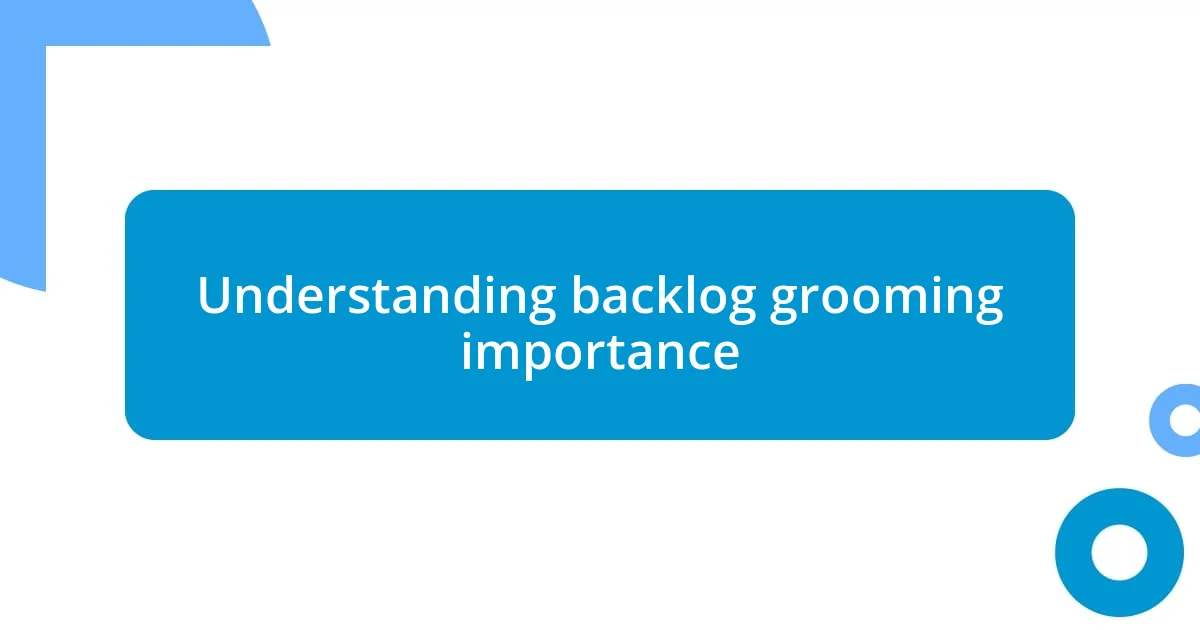
Understanding backlog grooming importance
Backlog grooming is crucial because it helps teams prioritize tasks effectively. I’ve often found that when my team dedicates time to grooming, we gain clarity on what truly matters. Have you ever felt overwhelmed by a long list of tasks? That’s why I believe regular grooming sessions can be a game changer, transforming chaos into structure.
When I’ve actively participated in grooming sessions, I noticed a palpable shift in team morale. It’s not just about managing the backlog; it’s an opportunity for collaboration and shared understanding. Don’t you feel more confident tackling tasks when everyone is on the same page? By discussing and refining our backlog together, we foster a sense of ownership and accountability.
The importance of backlog grooming also lies in its ability to adapt to changing circumstances. In my experience, new requirements or unforeseen challenges can arise unexpectedly, and a well-groomed backlog allows teams to pivot quickly. How often have you been caught off guard by sudden priorities? With a clear backlog, teams can respond effectively, ensuring that our efforts align with the most pressing needs.
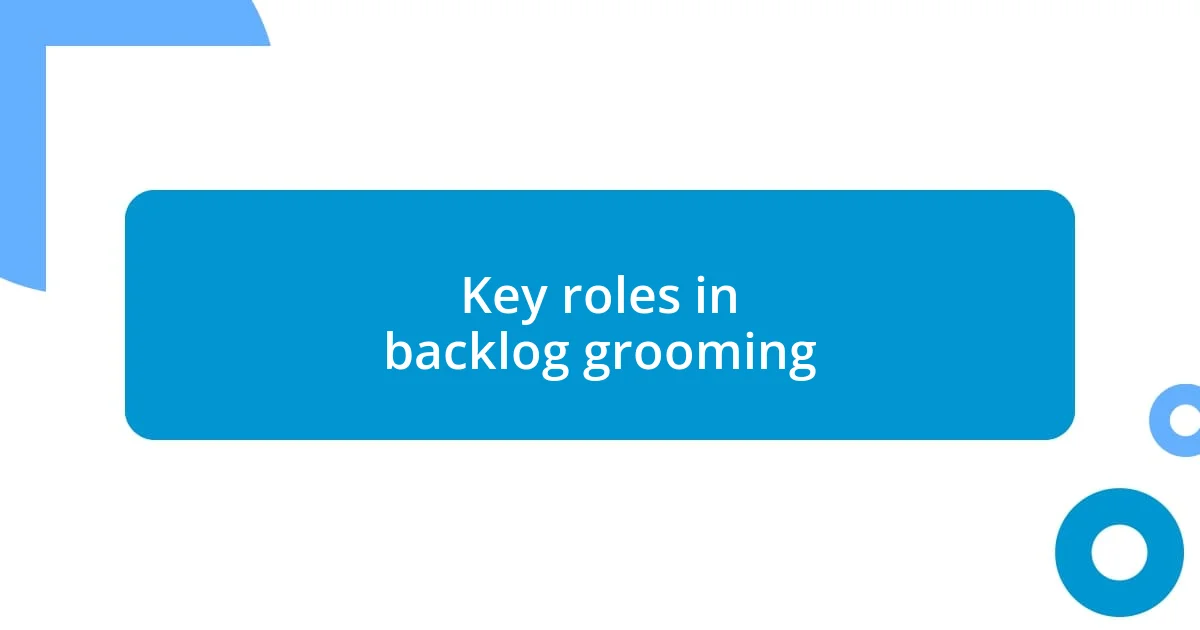
Key roles in backlog grooming
In my view, there are several key players in a successful backlog grooming session. The Product Owner often leads the charge, ensuring that the backlog items align with the overall vision and strategy. I’ve seen how their deep understanding of stakeholder needs can illuminate priorities for the team. Working with a strong Product Owner makes a tremendous difference; they communicate the ‘why’ behind each task, helping everyone grasp the bigger picture.
The Scrum Master or Agile Coach plays another crucial role by facilitating these sessions. In my own experience, their ability to create a safe environment allows team members to voice their opinions and concerns freely. It fosters an atmosphere of trust where collaboration thrives. Without that support, crucial feedback often goes unheard, leaving gaps in understanding.
Finally, the development team contributes indispensable insights during grooming. Their technical expertise helps assess the feasibility of tasks, which I’ve found is vital for realistic planning. When they share their perspectives on challenges or potential roadblocks, it encourages a holistic view of the backlog. After all, how can we prioritize effectively without understanding what’s achievable within our timeframes?
| Role | Responsibilities |
|---|---|
| Product Owner | Defines backlog items’ importance and ensures alignment with strategic goals. |
| Scrum Master | Facilitates the session, promoting communication and a collaborative environment. |
| Development Team | Provides technical insights and helps assess task feasibility. |
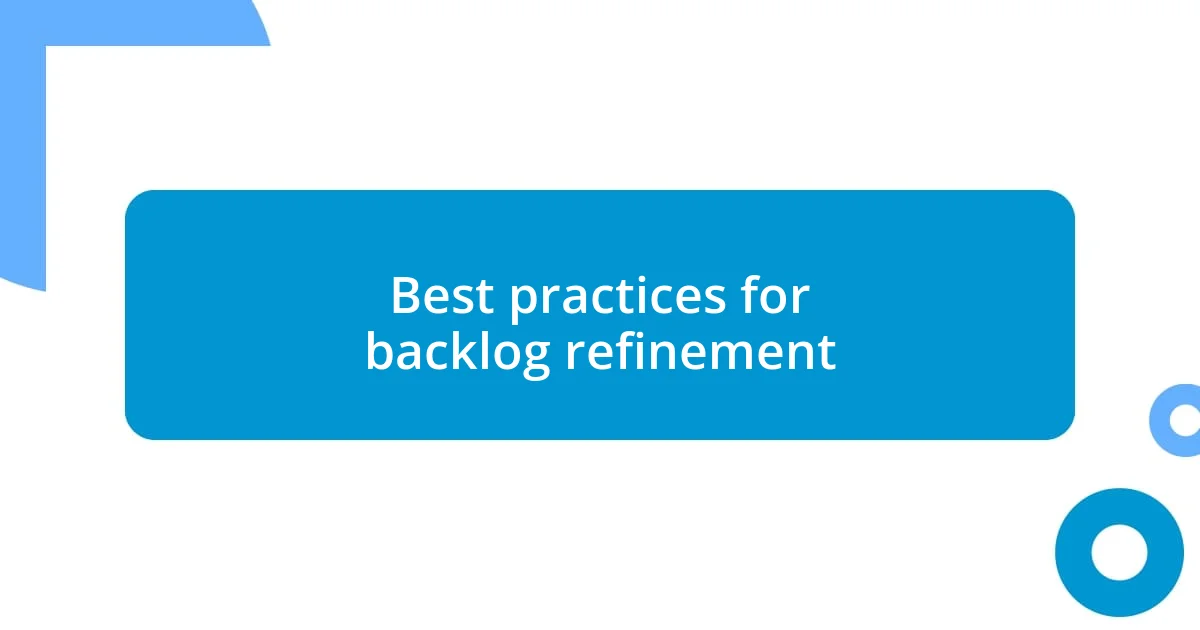
Best practices for backlog refinement
To ensure effective backlog refinement, I’ve learned that consistency is vital. Scheduling regular backlog grooming sessions—ideally once a sprint—creates a rhythm that everyone can anticipate. This predictability not only boosts participation but also helps maintain focus on evolving priorities. There was a time when I realized that ad-hoc sessions led to confusion; now, having a set schedule keeps us aligned and engaged.
Here are some best practices I’ve gathered over the years:
- Invite the right people: Ensure that the Product Owner, Scrum Master, and key development team members are present.
- Limit backlog items: Prioritize reviewing the top items instead of trying to tackle the entire backlog in one go.
- Encourage open dialogue: Create a space where everyone feels comfortable discussing their thoughts about priorities and challenges.
- Use clear criteria for prioritization: Define what makes an item high-priority (e.g., value to customers, alignment with strategic goals).
- Frequent revisions: Don’t hesitate to re-evaluate and refine items as the project evolves, keeping the backlog dynamic and responsive.
I recall a particularly vibrant session where team members shared insights that completely altered our understanding of a complex feature. Their contributions transformed what I thought was clear into a rich discussion that illuminated various perspectives. It’s moments like these that reinforce my belief in the power of collaborative refinement; it goes beyond just checking off tasks, ensuring the team is genuinely working towards what matters most.
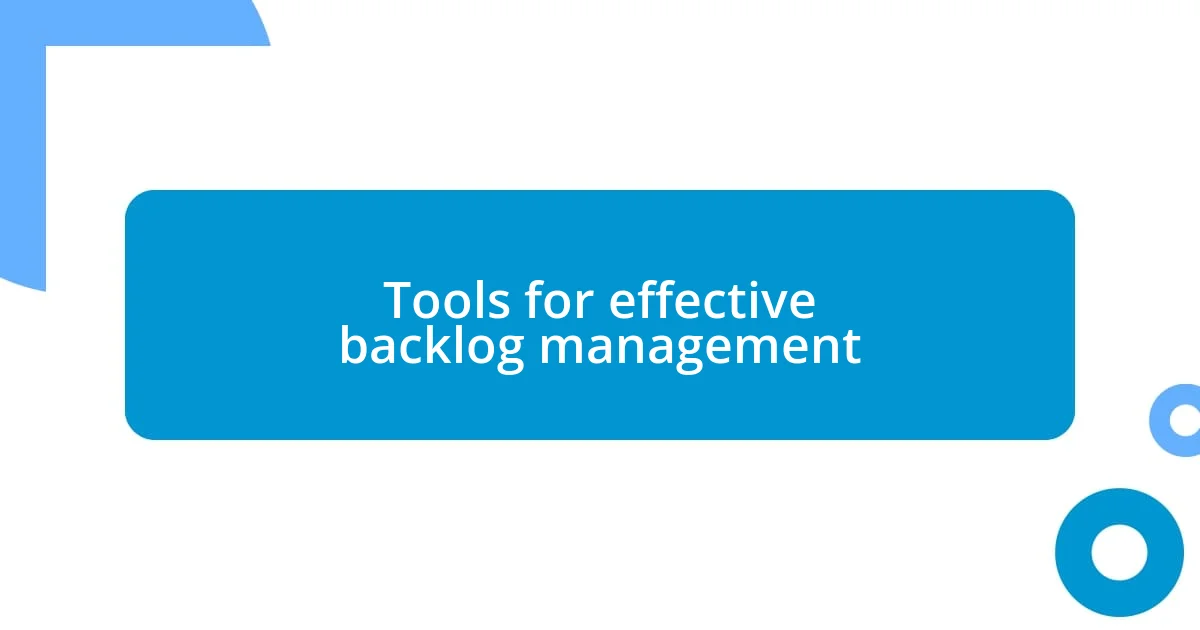
Tools for effective backlog management
When it comes to effective backlog management, I’ve found that the right tools can make all the difference. Software like Jira and Trello allows for clear visualization of tasks, which is invaluable for maintaining focus. I still remember a time when our team struggled to keep track of numerous tasks on a messy spreadsheet; switching to a visual tool transformed our organization. Isn’t it amazing how much clarity the right platform can provide?
Another standout tool in my experience is Asana. It offers a user-friendly interface and great features for team collaboration. I remember feeling overwhelmed during grooming sessions when updates were scattered across emails and meetings. Asana not only centralizes discussions but also allows team members to comment directly on tasks. This transparency fosters engagement, making everyone feel heard—don’t you think that enhances teamwork?
Lastly, I can’t overlook the power of a dedicated communication tool like Slack. Integrating it with your backlog management software can streamline updates and facilitate quick discussions. I recall one grooming session where a simple question in Slack clarified a misunderstanding that could have derailed our progress. It’s this kind of seamless communication that keeps the momentum going, right? Embracing these tools has helped me create a more organized and responsive backlog, ultimately driving our projects toward success.
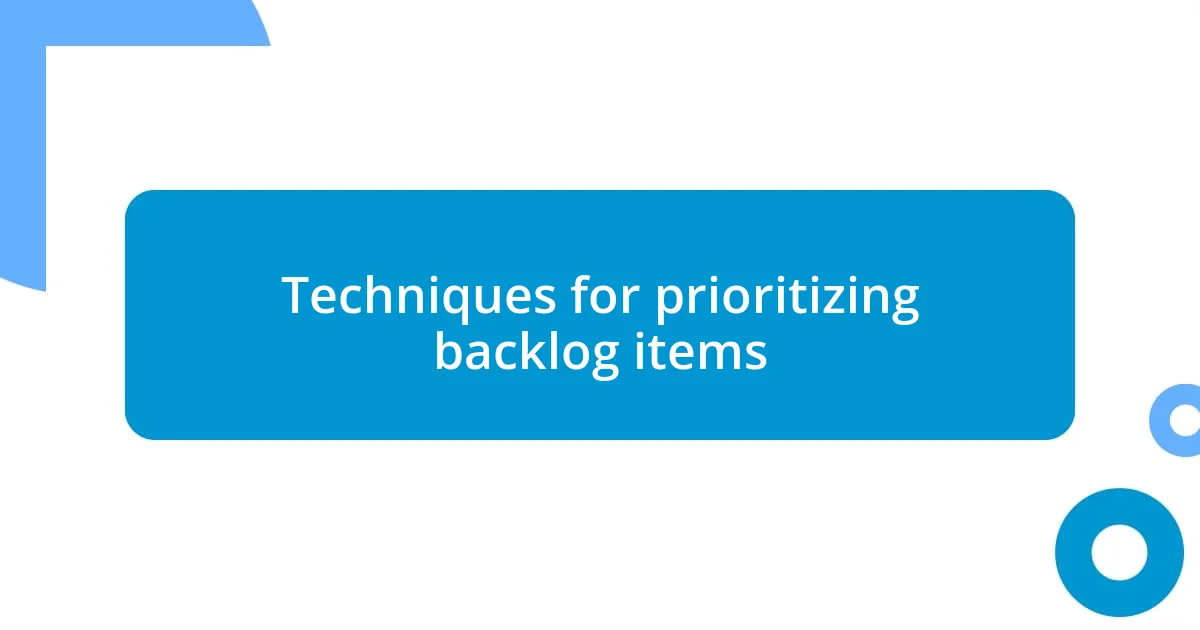
Techniques for prioritizing backlog items
Prioritizing backlog items can often feel overwhelming, but using techniques like the MoSCoW method can provide clarity. This method categorizes items into four groups: Must have, Should have, Could have, and Won’t have. I recall my first encounter with this technique—it transformed our team discussions. Suddenly, we all had a clear framework to guide our choices, making consensus easier to reach. Have you ever noticed how frameworks can simplify complex discussions?
Another effective approach I’ve found is using weighted scoring. By assigning numerical values to various criteria—such as business value, complexity, and risk—my team and I gained a tangible way to compare items. I remember the first time we applied this method; it was enlightening. Items that seemed equally important on the surface were suddenly ranked, directing our focus where it truly mattered. It’s fascinating how a few numbers on paper can drastically shift our priorities and decisions, don’t you think?
Lastly, I’ve experienced great benefits from involving the stakeholders directly in prioritization sessions. Their insights can unveil what aspects truly impact users, driving us to make informed decisions. There was a pivotal moment when a stakeholder expressed how a particular feature would enhance user experience—it shifted our focus entirely. Engaging stakeholders not only adds depth to our understanding but creates a sense of ownership among all parties involved. Isn’t it incredible how collaboration can shape our project trajectory?
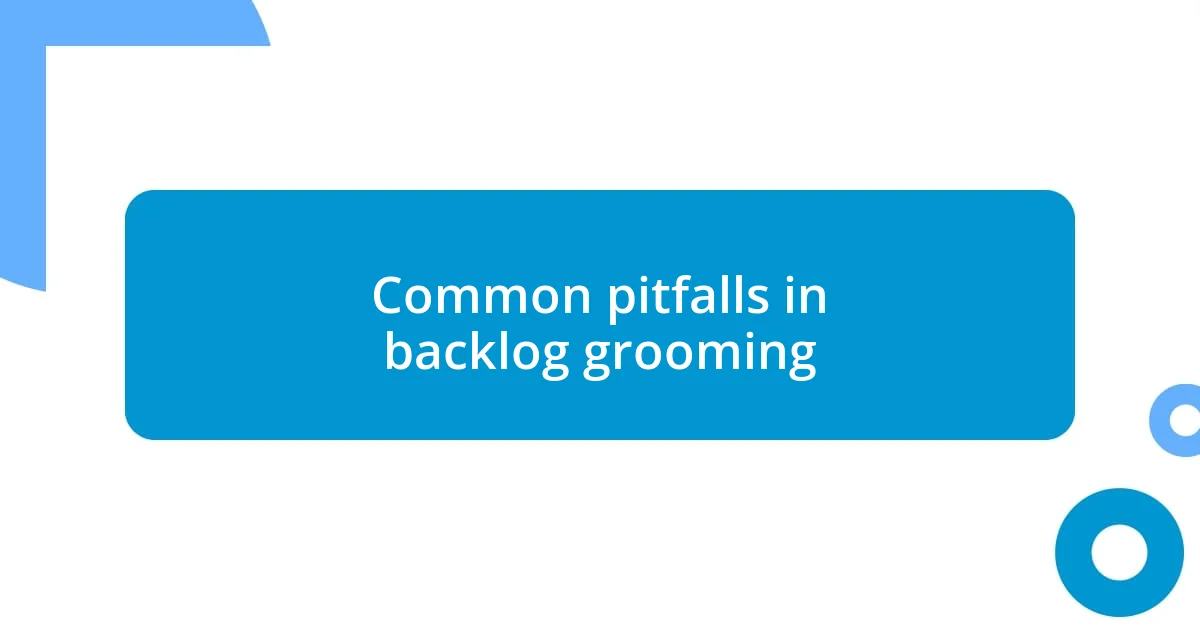
Common pitfalls in backlog grooming
One of the most common pitfalls I’ve encountered during backlog grooming is the tendency to overlook smaller tasks. It’s easy to get caught up in discussing major features while neglecting tiny yet crucial items. I once saw our team’s efficiency drop because we kept sidelining minor technical debt that eventually snowballed into bigger issues. Have you ever noticed how those small things can quietly pile up, creating larger headaches down the road?
Another frequent misstep is failing to update the backlog regularly. I remember a particularly chaotic grooming session where we spent most of our time sifting through outdated items that no longer held value. It was exhausting and frustrating for everyone involved. Keeping the backlog fresh and relevant is essential—without that, it just becomes a chore rather than an effective tool. Isn’t it frustrating when a valuable process turns into a burden because of neglect?
Lastly, I’ve seen teams struggle with decision-making due to indecisiveness during grooming sessions. It’s crucial to establish a clear criteria for prioritization to avoid getting stuck in discussions. Once, our team wasted an entire meeting debating the importance of a feature, only to realize later that nobody had a strong enough opinion. I learned that having a facilitator or a structured approach can really help break the cycle of indecision. How do you ensure your team stays focused and decisive in such discussions?
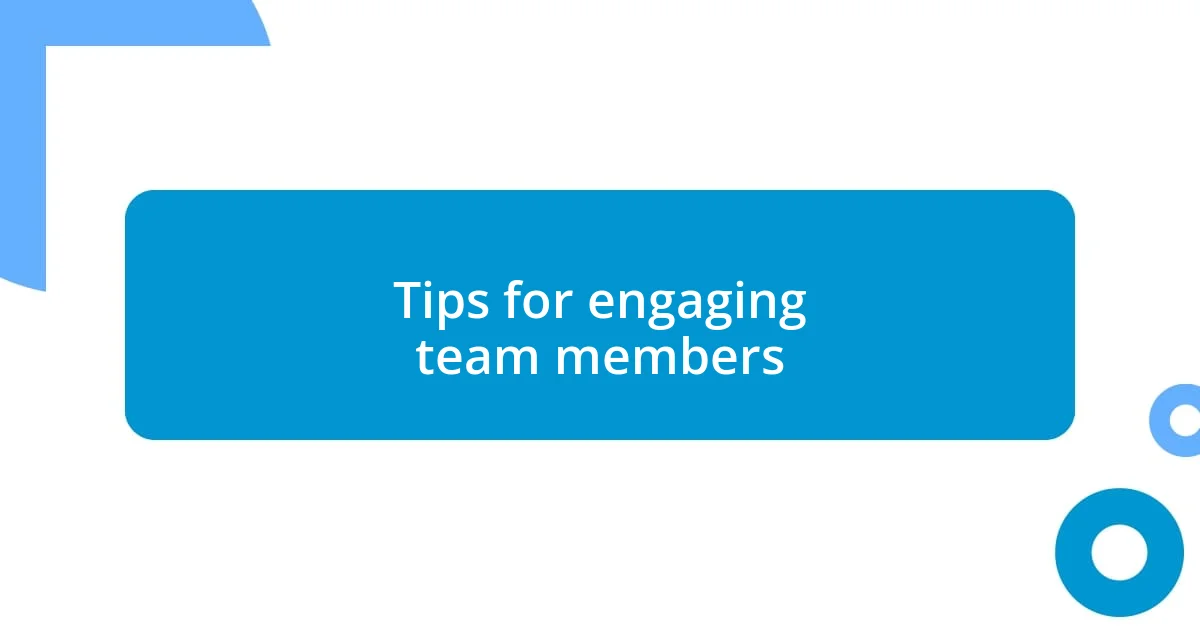
Tips for engaging team members
Engaging team members during backlog grooming can be a game changer. One strategy I’ve found effective is to create a ‘round-robin’ style discussion where each team member shares their thoughts on specific backlog items. I had a particularly enlightening session where this method uncovered some hidden concerns about a feature we all assumed was a priority. It made me realize how essential it is for everyone to voice their views—it fosters a sense of participation and shared ownership that motivates the entire team, don’t you think?
Another approach I’ve embraced is incorporating visual aids, like Kanban boards, to illustrate the status of items. I remember the first time I brought a backlog chart to our meeting; the energy shifted instantly. Everyone could see where we were versus where we wanted to be. Visuals are not just aids; they create a shared understanding, sparking dialogue and engagement. Have you ever noticed how a simple chart can ignite discussions that were otherwise stalled?
Finally, I believe it’s important to celebrate small wins throughout the backlog grooming process. When our team closed out a challenging backlog item recently, we took a moment to acknowledge the hard work that led to it. This recognition energized us and reminded us why we put in the effort. Celebrating progress, no matter how small, cultivates a positive team culture and keeps spirits high. How do you celebrate your team’s achievements?













